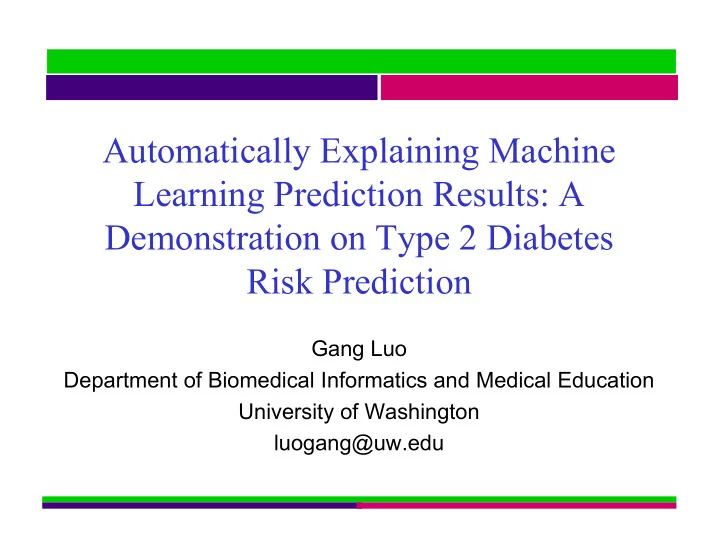

Automatically Explaining Machine Learning Prediction Results: A Demonstration on Type 2 Diabetes Risk Prediction Gang Luo Department of Biomedical Informatics and Medical Education University of Washington luogang@uw.edu
Clinical Big Data • Volume of healthcare data – Increase 50-fold in 8 years to 25,000 petabytes by 2020 • Diverse sources – Electronic medical records – Sensors – Mobile devices • Opportunities to advance clinical care and biomedical research 2
Predictive Modeling • Leverage these large, heterogeneous data sets to advance knowledge and foster discovery • Facilitate appropriate and timely care by forecasting – Health risk: Put high-risk patients into care management – Clinical course: Guide appropriate admission of bronchiolitis patients in the emergency department – Outcome: Assist with timely asthma diagnoses in children with clinically significant bronchiolitis 3
Approaches to Predictive Modeling • Statistical methods – E.g., logistic regression • Machine learning algorithms that improve automatically through experience (model training) – E.g., support vector machine – Neural network – Decision tree – Random forest 4
Outline • Pros and cons of machine learning • Our approach to address the challenge • Some results 5
Pros of Machine Learning • Often achieves higher prediction accuracy than statistical methods – Sometimes doubles prediction accuracy • With less strict assumptions on data distribution 6
Cons of Machine Learning • Use in healthcare is challenging • Most machine learning models give no explanation of prediction results – Most models are complex 7
Cons of Machine Learning – Cont. • Explanation is essential for clinicians to – Trust prediction results – Determine appropriate, tailored interventions • E.g., provide transportation for patients who live far from their physicians and have difficulty accessing care – Defend their decisions in court if sued for medical negligence – Formulate new theories or hypotheses for biomedical research 8
Challenge • Prediction accuracy and giving explanation of prediction results are frequently two conflicting goals • Need to achieve both goals simultaneously – Explain prediction results without sacrificing prediction accuracy 9
Outline • Pros and cons of machine learning • Our approach to address the challenge • Some results 10
Main Ideas • A model achieving high accuracy is usually complex and gives no explanation of prediction results • Challenge: Need to achieve high prediction accuracy as well as explain prediction results • Key idea: Separate prediction and explanation by using two models concurrently – The first model makes predictions and targets maximizing accuracy – The second model is rule-based • Used to explain the first model’s results rather than make predictions 11
Main Ideas – Cont. • The rules used in the second model are mined directly from historical data • Use one or more rules to explain the prediction result for a patient • Suggest tailored interventions based on the reasons listed in the rules 12
Outline • Pros and cons of machine learning • Our approach to address the challenge • Some results 13
Some Results • Test case: Predicting type 2 diabetes diagnosis within the next year • Electronic medical record data of 10K patients • Can explain prediction results for 87% of patients who were correctly predicted by a champion machine learning model to have type 2 diabetes diagnosis within the next year 14
Example Rule 1 • The patient had prescriptions of angiotensin- converting-enzyme (ACE) inhibitor in the past three years AND the patient’s maximum body mass index recorded in the past three years is ≥35 the patient will have type 2 diabetes diagnosis within the next year – ACE inhibitor is used mainly for treating hypertension and congestive heart failure – Obesity, hypertension, and congestive heart failure are known to correlate with type 2 diabetes • Example intervention: Enroll the patient in a weight loss program 15
Example Rule 2 • The patient had prescriptions of loop diuretics in the past three years AND the patient had ≥ 23 diagnoses in total in the past three years the patient will have type 2 diabetes diagnosis within the next year – Loop diuretics are used for treating hypertension – Hypertension and having a large number of diagnoses are known to correlate with type 2 diabetes 16
Example Rule 3 • The patient had ≥6 diagnoses of hyperlipidemia in the past three years AND the patient had prescriptions of statins in the past three years AND the patient had ≥9 prescriptions in the past three years the patient will have type 2 diabetes diagnosis within the next year – Hyperlipidemia: high lipid (fat) level in the blood – Statins are used for lowering cholesterol • Hyperlipidemia, high cholesterol level, and using many medications are known to correlate with type 2 diabetes 17
Example Rule 4 • The patient had ≥5 diagnoses of hypertension in the past three years AND the patient had prescriptions of statins in the past three years AND the patient had ≥11 doctor visits in the past three years the patient will have type 2 diabetes diagnosis within the next year – Hypertension, high cholesterol level, and frequent doctor visits are known to correlate with type 2 diabetes • Example intervention: Suggest the patient to make lifestyle changes to help lower his/her blood pressure 18
Thank you 19
Recommend
More recommend